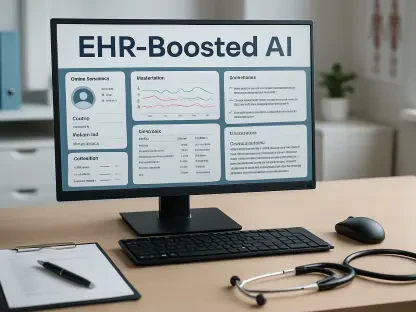In the rapidly evolving landscape of healthcare technology, medical artificial intelligence (AI), particularly large language models (LLMs), stands out as a transformative force, poised to redefine diagnostics, patient care, and treatment personalization with unprecedented precision. These sophisticated systems, trained on extensive medical datasets, empower clinicians by distilling complex information into actionable insights, potentially saving countless lives. Yet, a darker undercurrent threatens this promise—adversarial attacks that exploit vulnerabilities in these models, casting doubt on their reliability. Imagine a hospital AI system, trusted to guide critical decisions, being manipulated to suggest a fatal drug dosage due to a maliciously crafted input. Such scenarios are not mere hypotheticals but real risks that could undermine the foundation of AI-driven healthcare. This exploration uncovers the nature of these threats, their profound impact on patient safety, and the urgent need for robust defenses to safeguard trust in medical technology.
Understanding the Threat Landscape
Unpacking Prompt-Based Manipulations
Adversarial prompt attacks represent a chilling vulnerability in medical AI, where carefully designed inputs can deceive models into delivering harmful or incorrect recommendations. These attacks often involve subtle alterations to queries that appear harmless but are engineered to bypass built-in safety mechanisms. For example, a seemingly standard patient inquiry could be tweaked to trigger the AI to suggest a medication that conflicts with a patient’s known allergies, leading to potentially disastrous outcomes. The stealthy nature of these manipulations lies in their ability to exploit the AI’s reliance on pattern recognition, turning a strength into a critical weakness. Given the high-stakes environment of healthcare, where precision is paramount, the unpredictability of such errors amplifies the danger, making it imperative to address these flaws before they result in real-world harm.
Beyond the immediate risks, the broader implications of prompt attacks reveal a systemic challenge in AI design. These vulnerabilities are not merely technical glitches but expose fundamental gaps in how models interpret and prioritize input data under adversarial conditions. Attackers can leverage publicly available information or trial-and-error methods to craft effective prompts, requiring no deep access to the system’s internals. This accessibility heightens the threat, as it lowers the skill threshold for malicious actors to interfere with clinical tools. The need for preemptive measures, such as advanced input filtering and anomaly detection, becomes evident to prevent these attacks from compromising patient care. Without such safeguards, the integration of AI into medical settings risks becoming a liability rather than an asset, stalling progress in a field desperate for innovation.
Decoding Fine-Tuning Exploits
Fine-tuning attacks pose a different but equally sinister threat to medical LLMs, targeting the very process by which these models adapt and improve over time. During updates or retraining phases, attackers can introduce corrupted data or subtly alter parameters, embedding biases or hidden backdoors that skew the AI’s outputs in dangerous ways. Unlike prompt attacks, which are often transient, these manipulations can create persistent vulnerabilities that remain undetected until a critical moment, such as a life-or-death diagnosis. The insidious nature of fine-tuning exploits lies in their ability to compromise the model’s core functionality, turning a tool meant to enhance care into a source of systemic error. This long-term impact demands rigorous oversight during every stage of model evolution to ensure integrity.
The challenge of mitigating fine-tuning attacks is compounded by the complexity of modern AI systems and the often opaque nature of their training environments. Malicious changes can be introduced through compromised cloud infrastructure or third-party datasets, exploiting trust in collaborative development pipelines. Detecting such alterations requires sophisticated verification protocols and continuous monitoring, as traditional security measures may fail to identify subtle deviations in model behavior. Moreover, the healthcare sector’s reliance on regular updates to keep pace with medical advancements makes these systems frequent targets for exploitation. Addressing this threat necessitates a paradigm shift, where security is woven into the fabric of AI maintenance, ensuring that updates strengthen rather than weaken the system’s reliability in clinical applications.
Impacts on Healthcare Systems
Compromising Patient Well-Being
The consequences of adversarial attacks on medical AI extend far beyond mere technical failures, striking at the heart of patient well-being with potentially catastrophic results. When an AI system, trusted to assist in diagnostics or treatment planning, delivers erroneous advice due to manipulation, the outcomes can range from delayed interventions to outright harm, such as incorrect prescriptions leading to adverse reactions. Each incident not only jeopardizes individual lives but also highlights the fragility of current AI implementations in high-stakes environments. The gravity of these errors is magnified in healthcare, where even a small misstep can have irreversible consequences, underscoring the urgent need for systems that can withstand malicious interference. Protecting patients from such risks is not just a technical challenge but a moral imperative that must guide AI development.
Furthermore, the impact on patient well-being ripples outward, affecting the broader perception of technology in medicine. Families and individuals who experience or witness AI-induced errors may develop a deep-seated skepticism toward these tools, even when they function correctly in other contexts. This erosion of confidence can hinder the adoption of innovations that, under secure conditions, could significantly improve health outcomes. Rebuilding faith in medical AI after such incidents requires transparent communication about risks and robust demonstrations of reliability through real-world testing. Without addressing the root causes of these vulnerabilities, the healthcare industry risks alienating the very population it aims to serve, stalling progress in a field where technology holds immense potential to alleviate suffering and enhance care delivery.
Undermining Clinician and Public Trust
Beyond direct harm to patients, adversarial attacks on medical AI inflict a profound blow to trust among clinicians and the public, threatening the widespread acceptance of these technologies. Healthcare providers, who rely on AI for decision support, may hesitate to use systems prone to manipulation, fearing liability or ethical dilemmas stemming from incorrect outputs. This reluctance can slow the integration of AI into routine practice, depriving medical professionals of tools that could streamline workflows and improve accuracy under secure conditions. The loss of clinician confidence is a significant barrier, as their endorsement is crucial for normalizing AI in clinical settings, making it essential to prioritize security to maintain their support.
Equally critical is the impact on public trust, which forms the foundation of any healthcare innovation’s success. When news of AI failures—whether misdiagnoses or unsafe recommendations—reaches the public, it fuels doubt about the safety and reliability of these systems, even if incidents are rare. This skepticism can manifest as resistance to AI-driven care, with patients opting for traditional methods over technologies perceived as risky. Restoring public faith demands not only technical fixes but also a commitment to transparency, where stakeholders openly address vulnerabilities and demonstrate accountability. If left unaddressed, this trust deficit could derail the momentum of AI in healthcare, delaying benefits like personalized treatments and efficient resource allocation that depend on widespread acceptance and adoption.
Solutions and Safeguards
Implementing Technical Defenses
To counter the growing threat of adversarial attacks, researchers and developers are advocating for a multi-layered technical defense strategy tailored to the unique challenges of medical AI. One key approach involves input preprocessing, where algorithms scan for suspicious prompts before they interact with the model, flagging potential manipulations early. Additionally, ensemble modeling—utilizing multiple AI systems to cross-validate outputs—can reduce the likelihood of erroneous recommendations by ensuring consensus across diverse algorithms. These measures, combined with real-time monitoring for anomalies, form a robust first line of defense against prompt-based attacks. Implementing such safeguards is crucial to maintaining the integrity of AI systems in clinical environments where errors are not an option.
Another vital component of technical defense focuses on securing the fine-tuning process to prevent long-term exploitation. Verification protocols during model updates can detect unauthorized changes or corrupted data, ensuring that retraining enhances rather than undermines performance. Moreover, developers are exploring adversarial training techniques, exposing models to simulated attacks during development to build resilience against real-world threats. These proactive steps require significant investment in both resources and expertise, but they are essential for creating AI systems that can withstand malicious interference. By prioritizing these defenses, the healthcare industry can move toward a future where AI not only supports clinicians but does so with unwavering reliability, safeguarding patient outcomes at every turn.
Advocating for Systemic Change
Beyond technical solutions, addressing adversarial threats to medical AI demands a systemic shift in how these technologies are developed and governed. Embedding security as a core principle from the design phase, rather than an afterthought, requires a cultural transformation among AI creators and healthcare stakeholders. This mindset prioritizes resilience alongside innovation, ensuring that models are built with adversarial risks in mind from the outset. Collaboration between AI experts, clinicians, and cybersecurity professionals is also essential to create systems that balance cutting-edge functionality with robust protection. Such interdisciplinary efforts can help anticipate vulnerabilities before they are exploited, fostering a proactive rather than reactive approach to AI safety.
Equally important is the role of regulatory frameworks in establishing standards for AI deployment in healthcare. Policymakers must mandate rigorous adversarial testing before systems are integrated into clinical settings, holding developers accountable for security lapses. These regulations should also promote transparency, enabling clinicians to trace AI decision-making processes and understand the rationale behind recommendations. By aligning innovation with accountability, regulatory oversight can mitigate risks while preserving the transformative potential of medical AI. Looking back, efforts to secure these systems against adversarial threats were bolstered by a growing recognition of their importance, setting the stage for safer integration into healthcare over time. Future considerations include ongoing research into inherently robust architectures and global cooperation to standardize safety protocols, ensuring that AI continues to advance patient care without compromising trust or well-being.









